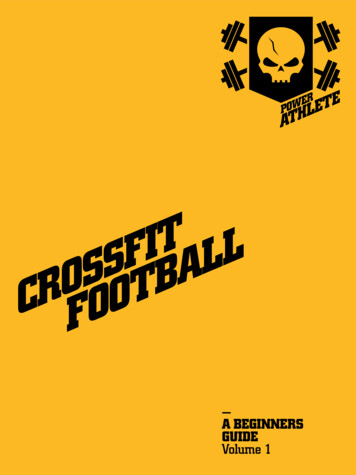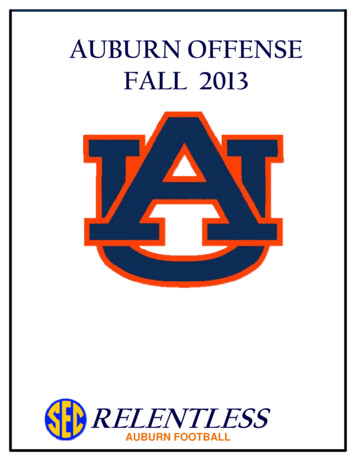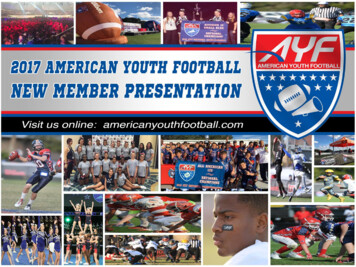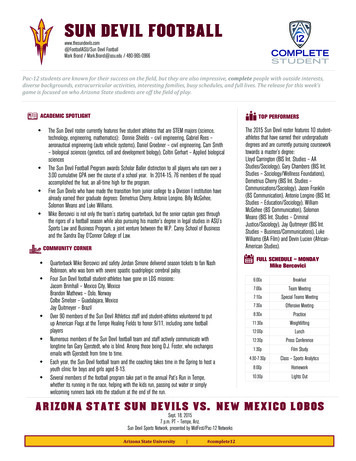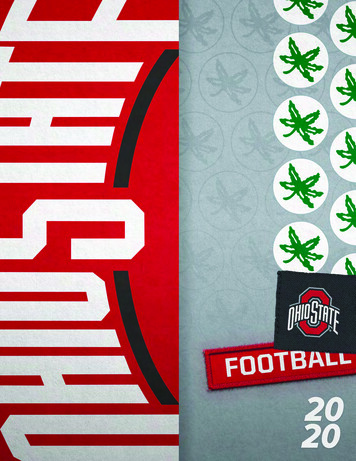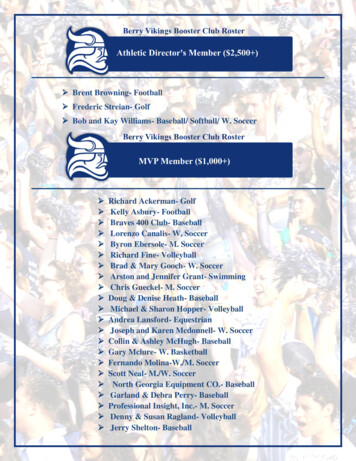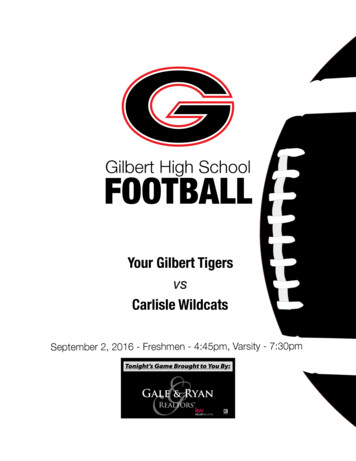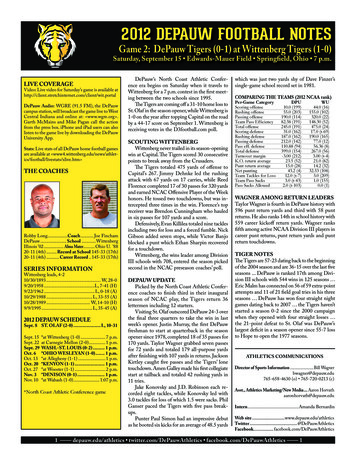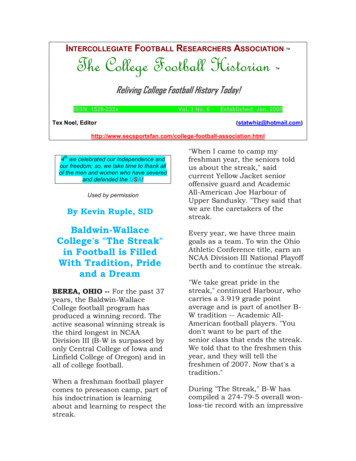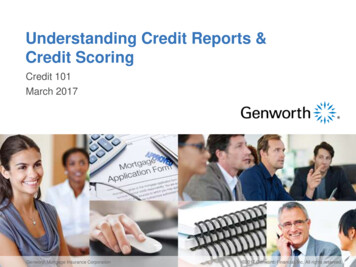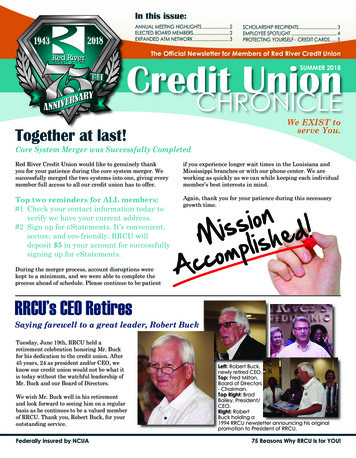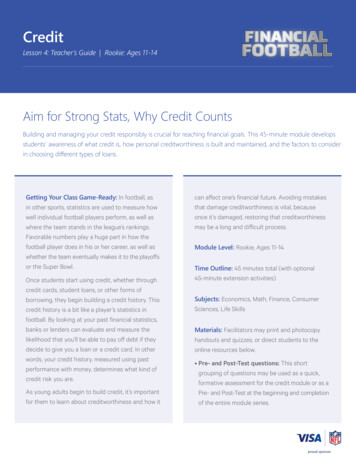
Transcription
CreditLesson 4: Teacher’s Guide Rookie: Ages 11-14Aim for Strong Stats, Why Credit CountsBuilding and managing your credit responsibly is crucial for reaching financial goals. This 45-minute module developsstudents’ awareness of what credit is, how personal creditworthiness is built and maintained, and the factors to considerin choosing different types of loans.Getting Your Class Game-Ready: In football, asin other sports, statistics are used to measure howwell individual football players perform, as well aswhere the team stands in the league’s rankings.Favorable numbers play a huge part in how thefootball player does in his or her career, as well aswhether the team eventually makes it to the playoffsor the Super Bowl.Once students start using credit, whether throughcredit cards, student loans, or other forms ofborrowing, they begin building a credit history. Thiscredit history is a bit like a player’s statistics infootball. By looking at your past financial statistics,banks or lenders can evaluate and measure thelikelihood that you’ll be able to pay off debt if theydecide to give you a loan or a credit card. In otherwords, your credit history, measured using pastperformance with money, determines what kind ofcredit risk you are.As young adults begin to build credit, it’s importantfor them to learn about creditworthiness and how itcan affect one’s financial future. Avoiding mistakesthat damage creditworthiness is vital, becauseonce it’s damaged, restoring that creditworthinessmay be a long and difficult process.Module Level: Rookie, Ages 11-14Time Outline: 45 minutes total (with optional45-minute extension activities)Subjects: Economics, Math, Finance, ConsumerSciences, Life SkillsMaterials: Facilitators may print and photocopyhandouts and quizzes, or direct students to theonline resources below. Pre- and Post-Test questions: This shortgrouping of questions may be used as a quick,formative assessment for the credit module or as aPre- and Post-Test at the beginning and completionof the entire module series.
Lesson 4 Credit: Teacher’s GuideOverview, cont. Blank index cards for vocabulary game Practical Money Skills Credit resources:practicalmoneyskills.com/ff12 Choose Your Own Adventure handout Practical Money Guides Credit History:practicalmoneyskills.com/ff14 True Cost of Credit handout Cost of Credit Financial calculator:practicalmoneyskills.com/ff15 Glossary of Terms: Learn basic financialconcepts with this list of terms.2
Lesson 4 Credit: Teacher’s GuideIcon KeyActivityAssign the given activity to students and have them complete it individually or with a group, dependingon the instructions.AskPose questions to your students and have them respond.AssignDesignate individuals or groups to complete a particular assignment.DebriefExamine the activities as a whole group and compare answers and findings.Did You Know?Share these fun facts with students throughout the lesson.Pre- and Post-TestHave students take the Pre-Test before the lesson, and take the Post-Test after completing the lesson.ShareRead or paraphrase the lesson content to students.Turn and TalkHave students turn to a partner and discuss a specific topic or question.3
Table of Contents Key Terms and Concepts 5 Module Section Outline and Facilitator Script9 Answer Keys 13 Credit Pre- and Post-Test 14 Choose Your Own Adventure handout15 True Cost of Credit handout 16 Glossary of Terms 174
Lesson 4 Credit: Teacher’s GuideLearning Objectives– Define credit, credit scores, and credit reports– Identify what builds creditworthiness– Examine the five Cs of credit (character, capital, capacity, collateral, and conditions)– Analyze the costs and benefits of credit cards and other types of creditKey Terms and ConceptsBefore you start the lesson, review the key terms and concepts below. The answers to each question will help you getstudents prepped and game-ready. Get deeper information around these concepts in the Facilitator Script section onpages 9 to 11 of this guide.What is credit and how does it affect my life?Credit is trusting someone to borrow money or something else of value and paying for it later. Credit can be a convenientand flexible form of payment, but it must be used responsibly in order for you to make the most of your money.How do I get a credit score and what does it mean?When you apply for credit, lenders determine your credit risk by examining a number of factors, including your creditscores from companies like FICO and VantageScore. Each of the three main credit bureaus — Experian, TransUnion,and Equifax — keeps credit information about you that is used to calculate your scores. This includes your paymenthistory, the amount of money you owe, the length of your credit history, and the number of recently opened creditaccounts. The resulting three-digit score reflects your creditworthiness — how likely you are to repay debts. Scorescan vary between 300 and 850. If you haven’t ever had a loan in your name you may not have a score — just like aplayer who hasn’t played in a game yet.What is on my credit report?Your credit report shows how you’ve handled your finances. Credit scores are based on a review of your credit report.Your credit report is a statement that has information about your credit activity and current credit situation, such asloan paying history and the status of your credit accounts. Just like a football player’s stats or a student’s report card,it shows how you are doing with your money.How do I get to see my credit report?Everyone who is 18 years or older is entitled to receive a free copy of their credit report once every 12 months. Onceyou are 18, you can order yours online from annualcreditreport.com or by calling 1-877-322-8228. You will need to verifyyour identity with your name, birth date, address, and Social Security number.5
Lesson 4 Credit: Teacher’s GuideLearning Objectives, cont.How can I build my creditworthiness?Credit scores change over time; they go up or down based on how much debt you owe and how you manage your bills.If someone has late payments or owes a large amount of money, it can decrease their credit score dramatically.When I turn 18, how can I build my creditworthiness?1. Build your Character:ü Always pay your bills on time.ü When you are confident you can manage the responsibility of a credit card, consider opening a securedcredit card account. Always pay your credit card balance in full and on time each month and maintainbalances below 10% of your credit limit.ü Protect your identity. If your credit card is lost or stolen, report it to the issuer immediately. Check eachcredit report once a year for inaccuracies and immediately report errors to resolve any issues.ü Do not apply excessively for credit.2. Grow your Capital:ü Use savings strategies to save for the down payment of a future loan.3. Establish evidence of your Capacity to repay loans:ü Establish a consistent work history and increase your cash flow.ü Avoid over borrowing. Whether it is a student loan, mortgage, a credit card, or an auto loan, just becauseyou qualify to borrow a certain amount doesn’t mean you have to borrow that amount.4. Document Collateral:ü Ensure you have a list of property or assets, as some lenders may require you to put up this collateral forcertain types of loans.5. Assess Conditions:ü Take stock of why you need the loan (such as buying a car), the amount you are requesting, and the currentinterest rates, as lenders may want to know these details.ü Consider conditions that are out of your control, like the current state of the economy.10 ways to keep your credit score strongEach of these strategies will help you grow and manage your credit over time.1. Complete credit applications carefully and accurately.2. Use your credit cards responsibly — don’t spend more than you can reasonably pay back. Be careful notreach your credit card’s limit (the total amount available to borrow).3. Choose your credit cards wisely and make sure you understand all of the terms and features.6
Lesson 4 Credit: Teacher’s GuideLearning Objectives, cont.4. A ttempt to pay your credit card balance in full each month, but at least make the minimum payment by thedue date.5. Always pay bills on time.6. If you have problems paying your bills, contact your creditors. In many cases, they will work with you tofigure out a payment plan.7. If you move, let your creditors know your new address as soon as possible to avoid losing bills or receivingthem late.8. If your credit card is lost or stolen, report it to the issuer immediately.9. Check your credit reports periodically for inaccuracies and immediately report errors to resolve any issues.10. Establish a consistent work history.How do I choose the best credit card or loan?The best way to maximize the benefits of loans, including student, auto, credit card, personal, and peer-to-peer loanoptions, is to understand your financial lifestyle — what you need, what you want, and how much money you spend.Begin your search for a credit card by determining key factors like how often you’ll use it, whether you’ll want to use itoverseas, and if the financial institution that offers it has a branch near you. It’s important to make sure you know theterms of the credit card in the following areas: Annual percentage rates (APRs) and whether rates are fixed or variable. This rate shows you how muchinterest you will be charged if you do not pay your full bill each month. Annual, late, and overdraft-limit fees; are different fees that you can be charged for having a credit card.Some cards have an annual membership fee. All credit cards charge late fees if you miss a payment. Somecredit cards charge overdraft-limit fees if you spend more than your credit limit. Credit limit on account, this is the maximum amount you are allowed to borrow (spend) from your credit card. Grace periods before interest begins accruing. Rewards, including airline miles or cash back.Consider your options and be smart about other loans you take out, including:Student Loans – If you need to borrow money to cover your college tuition, you normally take out a student loan.There are a few options to consider, including federal loans and loans from private companies.Auto Loans – You may be able to buy and finance a car through an auto loan from a car dealership, bank, or creditunion. You may also take out a home equity loan, which allows you to use your home as collateral for your auto loan.7
Lesson 4 Credit: Teacher’s GuideLearning Objectives, cont.Personal Loans – A personal loan can be used to cover various costs, from repaying credit card debt to taking anexpensive vacation, at your discretion. Personal loans can be secured or unsecured, depending on whether you havecollateral and the risk you want to take.Peer-to-Peer Loans – You can use an online service to match up with a peer lender, whether you want a loan forpersonal purposes or another reason. Many of these loans are unsecured, and since operations are conducted entirelyonline, you should approach peer-to-peer loans with caution.8
Lesson 4 Credit: Teacher’s GuideModule Section Outlinewith Facilitator ScriptIntroduction: Warm-Up Share: Get your students warmed up before playing the game by teaching them more about theconcept of credit. Start by sharing stories about the wise use of credit to help students develop goodpersonal finance habits. After sharing those examples, poll your class by asking the question in theprompt below. Ask: Ask students: Once you’re 18 years old, do you think a credit score will impact your ability to geta cell phone on your own or rent an apartment? (Answer: Yes) We’ll explore the many ways our creditscore affects our financial opportunities. Optional Pre-Test: Have students turn to page 9 of the Student Activities guide to take the optionalPost-Test.Credit Basics & Credit Cards Assign: Have students work in pairs to calculate the numbers in the series of provided purchasescenarios on the Choose Your Own Adventure handout on page 10 of their Student Activities Guide. Assign: Assign students The True Cost of Credit activity on page 11 of their Student Activities guide.Break students into pairs and ask them to review each scenario and answer questions on how long it willtake to pay the loan off and how much they will pay in finance charges using the Cost of Credit financialcalculator: practicalmoneyskills.com/ff15. After each student completes the activity in pairs, conduct a“Turn and Talk” session where students discuss with each other of how credit cards work. Directions: Break students into two teams and play a short trivia vocabulary game, Getting to KnowCredit Cards terms, using the definitions at the Credit section of Practical Money Skills’ website.practicalmoneyskills.com/ff12 Split the words between two teams and give teams two minutes to write down terms on the front ofindex cards and short definitions in the back. As the facilitator, you can have student teams take turns each pulling a card; then guess either theterm based on the definition or the definition based on the term. Activity: True Cost of Credit9 Share: Credit cards can be powerful financial tools for you and your family, and as with all financial products,they need to be used carefully. A credit card allows you to purchase necessary items now and pay later.
Lesson 4 Credit: Teacher’s GuideModule Section Outline with Facilitator Script, cont. Group Debrief: Discuss how a high APR and only making minimum payments lead to paying higheramounts over time. Outline the responsibilities that come with credit cards.Credit Scores: Why the Numbers Matter sk: Pose these questions to students: How many of you have heard of the term credit score? What is aAcredit score? Take a few responses/guesses. Share: After you have asked your students whether they’ve heard the term credit scores, share factsabout how credit scores are calculated. A credit score is a three-digit number that represents ourcreditworthiness. It scores how likely we are to repay debts. The higher our score, the more lenders trustour ability to repay funds. Scores can range between 300 and 850. (For older students, add the following:Credit scores have been used for decades to measure individuals’ ability to handle debt. When you applyfor credit, lenders determine your credit risk by examining a number of factors, including your creditscores from companies like FICO and VantageScore. Share the 5 C’s of credit with students to help themunderstand how they can build creditworthiness. Ask: What things do you think are used to calculate a credit score? Share: Credit score calculations are based on a review of your credit report. Your credit report, like afootball player’s stats or a student’s report card, shows how you’ve handled tasks. The primary factorsconsidered are your payment history, how much you owe, the length of your credit history, the differenttypes of credit you have used, and new applications for credit. Activity: Choose Your Own Adventure Ask: Ask students to imagine their future selves as one of the following characters — 19-year-old Jamieor 26-year-old Malcolm. Have them turn to page 10 of their Student Activities guide for the Choose YourOwn Adventure activity. Explain to students that if they don’t pay their loan payments on time, it canaffect their credit scores. Introduce each scenario as the story of a character; ask students to predict ifthe person’s credit score is likely to be poor (below 580), fair (580-669), good (670-739), or very good(740 ). Students can work in pairs or individually for this activity. Quick Tips: Have students discuss what actions each of the character’s took that helped or hurt theircredit. (Malcolm is paying his bills on time and building a higher score. Jamie has a lot of credit carddebt and doesn’t always pay bills on time, which is creating a lower score.) Share: Emphasize that our track record of decision-making (character), our current financial situation(capital), our ability to pay back debt (capacity), property or assets we have that can be put up if requiredby a lender (collateral), and the state of the economy (conditions) all factor into our creditworthiness.101. Character. A lender may decide whether you are honest and reliable to repay debt, based on yourcredit history. Lenders are likely to look at your credit use, bill payment, residential history, and how
Lesson 4 Credit: Teacher’s GuideModule Section Outline with Facilitator Script, cont.long you’ve worked at your current workplace.The most effective way to strengthen your credit reliability is to make payments on time. Many creditcard companies offer free, automatic alerts to help you keep track of your balances, payment duedates, payment history, and purchase activity.2. Capital. A lender will want to know if you have valuable assets, such as real estate, personal property,investments, or savings, with which to repay debt if income is unavailable.3. C apacity. This refers to your ability to pay off debt. Lenders will look to see if you have been workingregularly in an occupation that is likely to provide enough income to support your credit use. Theymay look at your salary, check whether you have pre-existing loans or debts, and assess whether youhave family members who depend on your earnings.4. C ollateral. A lender may require you to put up some form of collateral — a property or asset — forcertain types of loans like auto loans. When you take out a car loan, the vehicle you buy is typicallyused as collateral for the loan.5. C onditions. This refers to the condition of the economy and how it may affect your ability to repaythe loan. Share: To predict your financial future, many businesses look at your financial past through your creditreport. A credit history is a profile within a credit report that shows how you’ve handled money in the past.Your credit report is kept on file by three independent credit bureaus: Experian, TransUnion, and Equifax. The Credit History Practical Money Guide (practicalmoneyskills.com/ff14) is a tool that shows what kindsof factors are included in our credit report and gives practical tips for keeping credit strong. Display theguide to the class, and note what outside parties are legally entitled to see our credit report.Who can see your credit report? Potential employers Banks and credit unions Credit card issuers Landlords Auto financing companies Insurance companiesClosing: Group Discussion Quick Tips: Have students identify one simple rule of thumb to help them remember how to use creditresponsibly. What rule do students think would be wise?11 Optional Post-Test: Have students turn to page 9 of their Student Activities guide to take the optionalPost-Test.
Lesson 4 Credit: Answer Keys Credit Pre- and Post-Test Choose Your Own Adventure handout True Cost of Credit handout
Lesson 4 Credit: Teacher’s GuideCredit Pre- and Post-TestDirections: Have students answer the questions with the most appropriate answer, noting a, b, c or d.Answer Key1. The best way to build your credit score is to avoid borrowing money.a. Trueb. False2. If someone only pays the minimum credit card payment, they will owe interest on the money borrowed.a. Trueb. False3. The faster you pay back the money you borrow, the lower the amount of interest you will pay.a. Trueb. False4. You are not responsible for late fees on your credit card during vacation.a. Trueb. False5. A good way to begin building credit is:a. Pay bills on timeb. Open and pay off a loanc. Maintain a credit card balance that is less than 10% of your credit limitd. All of the above13
Lesson 4 Credit: Teacher’s GuideChoose Your Own AdventureYour credit score is a number between 300 and 850, assigned to you by a credit bureau, that helps lenders decidehow creditworthy you are — the higher the score, the lower the risk
Some cards have an annual membership fee. All credit cards charge late fees if you miss a payment. Some credit cards charge overdraft-limit fees if you spend more than your credit limit. Credit limit on account, this is the maximum amount you are allowed to borrow (spend) from your credit
